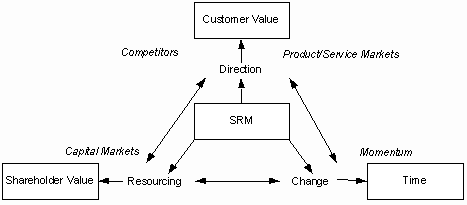
Summary by Cathy Riemer
Master of Accountancy Program
University of South Florida, Summer 2002
Knowledge Management Main Page | Strategy Main Page
The focus of management accounting has changed over the years. Historically, the focus of management accounting was on financial information. Factory accounting, budgeting and cost accounting were the main activities performed. Management accountants provided support in areas of planning and control using financial data. Non-financial data was used only in providing financial advice.
The old methods of management accounting were challenged in the 1980’s. Organizations began to incorporate suppliers and customers into their strategic decisions. Planning and control became important in a different perspective. Organizations began to reconfigure themselves in order to support the changes. Cross-functional teams were created and the workforce became more empowered.
Strategic Resource Management
Strategic resource management emphasizes the relationships between strategy formation, change management, and resource management. It provides answers to questions such as: what resources does the firm have and how can they create new resources, how do current resources support organizational strategies, and how can resources be used and re-used over time. Strategic resource management looks for value while trying to eliminate waste. Under a strategic resource management system, management accountants will be able to participate in resource-related direction setting, in the design and implementation of organizational change, and in the development of control systems and performance measurements.
The challenge of strategic resource management is that accountants will have to add value as part of the management team along with inventing approaches and learning new skills.
This challenge arises from the issues of value and time. The term "value" is described as a shift in customer or shareholder perceptions. It no longer consists of only financial measures. Management accountants must now look at non-financial measures such as the value of workers and technology when making evaluations.
Figure 1 illustrates the strategic resource management process:

Figure 1. Strategic Resource Management (p. 45).
Knowledge Management in Organizations
Sustaining a competitive advantage is linked to the existence or creation of core competencies. A core competency is a form of knowledge. When an organization has the knowledge to perform a task better than other organizations, it has a core competency. A core competency has many different forms. A unique work method, a unique mode of communication, and unique physical possessions can all be considered core competencies.
Australis: A Case Study
In 1991, the Australis Corporation took on an activity-based costing project to add to a total quality management initiative in the corporation. The project focused on overhead and non-factory costs. The key aspect of this project was to increase knowledge of the relationship between activities and costs in the company.
Phase one focused on cost reconstructions, mainly in the department head level. It reconstructed costs in terms of activities, processes, and product groups. This was done using driver analysis. The outcome showed that a number of low-volume products were undercosted because setup costs were not being recognized. It also showed other problems such as packaging costs, maintenance costs, and equipment replacements were not correctly allocated in certain situations.
Phase two focused on activity-based performance improvements. This phase looked at activities and performance directly in order to define new activity/cost relationships. Both non-value and value added activities were examined.
There were three main outcomes to this project. First, it provided a process orientation. During the project, it was noticed that there were different cultures in different parts of the corporation. The ABC portion showed how structure dominated process in the company. Next, it provided a set of diagnostic tools for employees. Staff members were given the knowledge to evaluate their own activities. Third, the project began the process of sharing knowledge across departments within the company.
In conclusion, management accounting is now being used as a mechanism for strategic resource management. Together, all types of resources can be examined and a new type of management through "knowledge" is created.
__________________________________________________
Related summaries:
Chow, C. W., F. J. Deng and J. L. Ho. 2000. The openness of knowledge sharing within organizations: A comparative study of the United States and The People's Republic of China. Journal of Management Accounting Research (12): 65-95. (Summary).
Davenport, T. H. and J. Glaser. 2002. Just-in-time delivery comes to knowledge management. Harvard Business Review (July): 107-111. (Summary).
Staats, B. R. and D. M. Upton. 2011. Lean knowledge work: The "Toyota" principles can also be effective in operations involving judgment and expertise. Harvard Business Review (October): 100-110. (Summary).